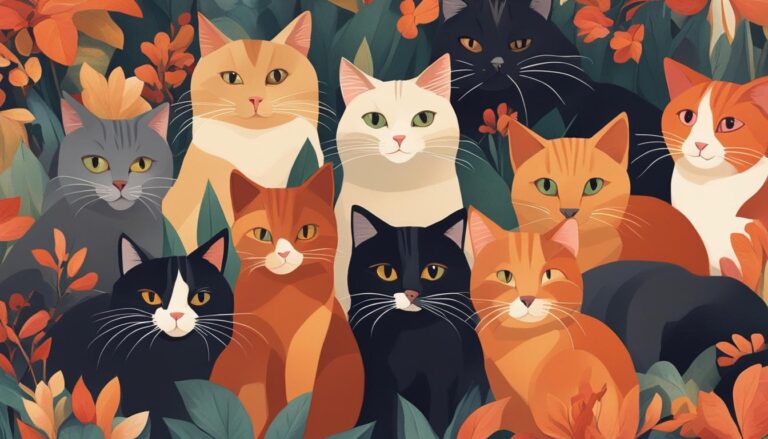Welcome to the fascinating world of feline collective terms! Have you ever wondered what a group of cats is called? Well, you’re in for a treat. In this article, we’ll explore the various names used to describe a gathering of our beloved furry friends. From “clowder” to “cat gang,” we’ll uncover the intriguing linguistic nuances behind these terms. So, let’s dive in and satisfy our curiosity about the collective identity of our purring companions.
Основные выводы:
- A group of cats is commonly referred to as a “clowder” or a “feline group” in British English.
- Other terms used to describe a gathering of cats include “cat collective,” “cat gang,” “cat clan,” “cat herd,” and “cat pack.”
- Cats form clowders for reasons such as social bonding, sharing resources, and protection.
- The size and dynamics of a clowder can vary depending on the environment, available resources, and individual cat behavior.
- The term “clowder” originated from Middle English and has been featured in literature, including T.S. Eliot’s “Old Possum’s Book of Practical Cats.”
Why Do Cats Form Clowders?
Cats, known for their independent nature, may seem like solitary creatures. However, they also have a social side, as evident in their formation of clowders. Understanding why cats form clowders can shed light on their behavior and socialization patterns.
One key reason for clowder formation is the availability of food and resources. Cats are opportunistic hunters, and they gather in groups in areas rich in food sources, such as garbage dumps or places where humans provide food for stray cats. By forming clowders, cats can increase their chances of accessing abundant food and sharing vital resources.
Protection is another motive for clowder formation. Cats, especially those in feral colonies, band together to defend themselves against potential threats. By forming a collective, cats can deter predators and safeguard their young from harm. This protective instinct is deeply rooted in their survival instincts.
Furthermore, clowders provide opportunities for socialization. Cats are inherently curious and playful creatures, and interacting with other felines allows them to engage in social bonding, play, and grooming. This socialization is particularly crucial for kittens, as it helps them develop vital life skills and establish their position within the clowder hierarchy.
Influencing Factors:
To summarize, the factors influencing clowder diversity включают:
- The environment in which the cats live
- The availability of resources such as food, water, and shelter
- The individual behavior of the cats
- The mix of feral and domestic cats within the clowder
Understanding these factors provides valuable insights into the social behavior and dynamics of clowders. By considering the various influences, we can gain a better understanding of how cats interact and form social groups.
The Curious Origin of the Word “Clowder”: Tracing the History of this Feline Collective Term
The term “clowder” may not be a commonly used word in everyday conversation, but its origin can be traced back to Middle English. Specifically, it derives from the words “clodder” and “mess,” which both refer to a mass or stack. Over time, the term “clowder” evolved to describe a group or gathering of cats.
Although the term may not be widely known, it has made appearances in literature, further cementing its place in the English language. One notable example is T.S. Eliot’s “Old Possum’s Book of Practical Cats,” a collection of cat-themed poems. In this literary work, the term “clowder” is used, demonstrating its historical presence and usage.
“And we won’t mention cats, not one little moggy…And we’ll have a nice clowder of cats, if you please.”
– T.S. Eliot, Old Possum’s Book of Practical Cats
Сайт etymology of the word “clowder” showcases the fascinating development and evolution of language. From its Middle English roots to its usage in literature, it is an intriguing term that adds to the richness of the English language.
| Key Points | Details |
|---|---|
| Origin | Middle English words “clodder” and “mess” meaning a mass or stack |
| Usage | Appears in T.S. Eliot’s “Old Possum’s Book of Practical Cats” |
| Etymology | Reflects the evolution and development of language |
Заключение
In conclusion, a group of cats is called a “clowder.” This term highlights the social nature of cats and their ability to form bonds with each other. Cats are not solitary creatures, but instead, they thrive in social interactions and develop strong relationships within their clowders.
Cats form clowders for various reasons. One of the main motivations is the sharing of food and resources. By gathering in groups, cats can increase their chances of finding and accessing abundant food sources, especially in areas where humans provide sustenance for stray cats.
Furthermore, clowders provide a sense of protection for cats. By joining forces, they can defend themselves and their young against potential threats. This safety in numbers allows them to establish territories and maintain a collective watch over their surroundings.
Clowders also serve as a means of socialization and play for cats. Within these groups, cats can groom each other, engage in mutual grooming, and participate in interactive play sessions. These social interactions are crucial for kittens as they learn important life skills and establish their position within the clowder hierarchy.
Understanding the factors that influence clowder diversity, including the environment, available resources, individual cat behavior, and the presence of feral and domestic cats, provides valuable insights into cat socialization and behavior. By recognizing and appreciating the social nature of cats, we can create environments that promote their well-being and encourage the development of strong cat bonds.




